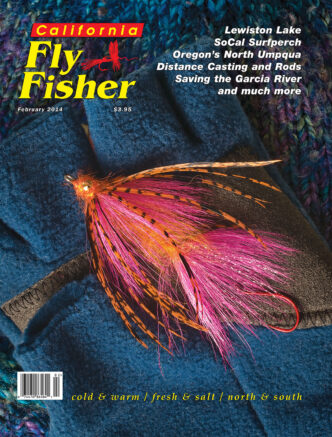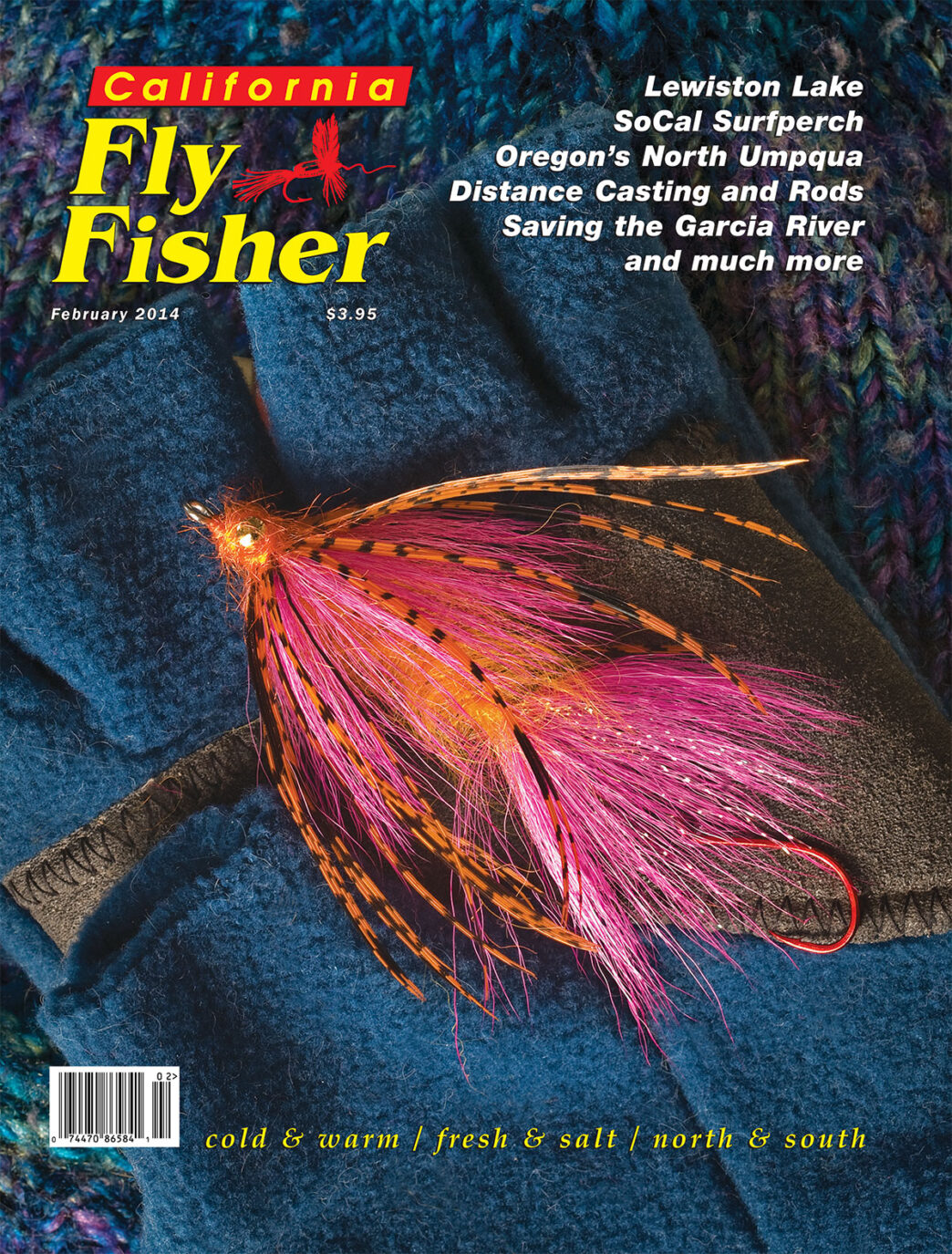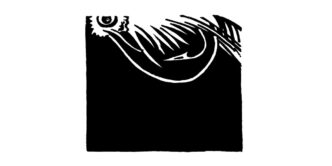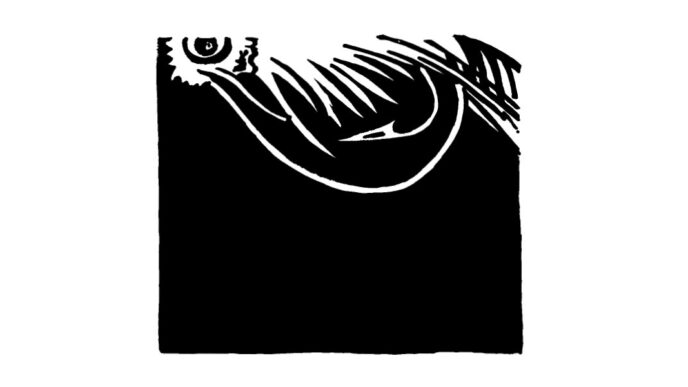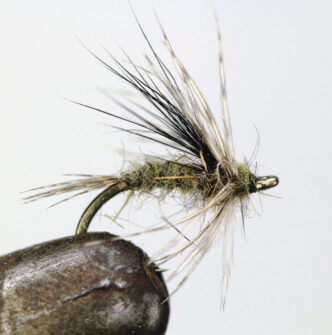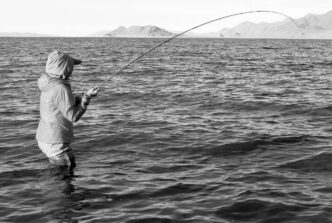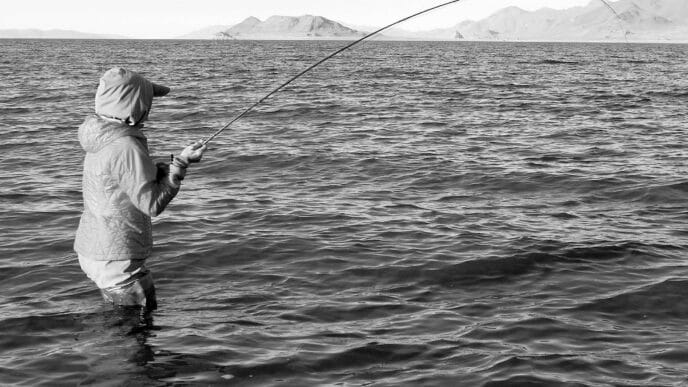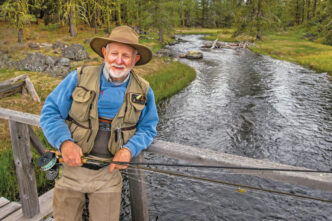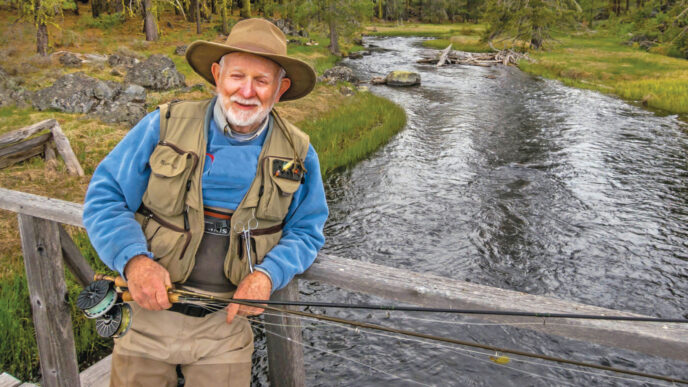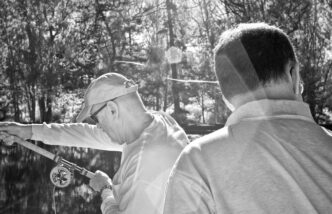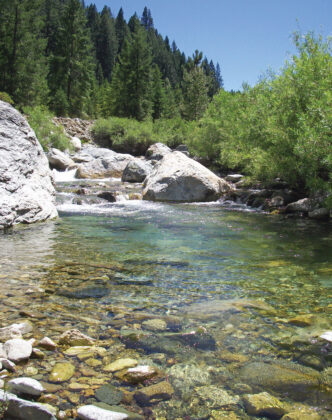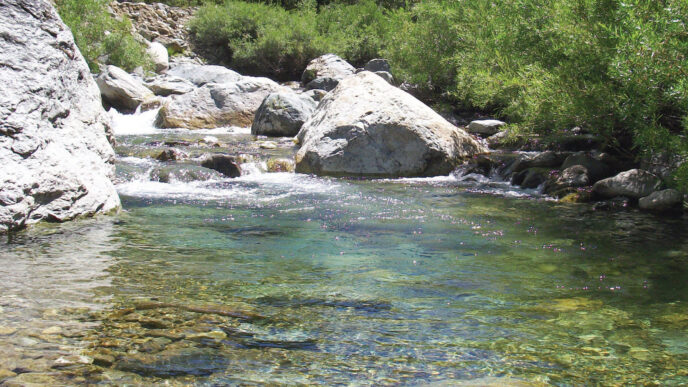Every subculture produces its private stars, people who are unknown to the rest of us but who are giants to the aficionados. Pool shooters have theirs, no doubt; likewise bridge players and mountain climbers. Arnold Schwarzenegger was a god among bodybuilders long before he was known to the rest of us.
— Geoffrey Norman,
from his Introduction to Ernest Schwiebert’s
Death of a Riverkeeper
Many years ago, long before the arrival of the New Zealand mud snail, Putah Creek was an important winter trout fishery. Angling was founded on releases of cool water from the depths of Lake Berryessa and a lush aquatic plant population that fostered phenomenal underwater insect growth. Today, however, those who drive north of Vacaville on Interstate 5 past the town of Winters and look west toward the deep gap in the coastal range that is Putah Creek breaking out of the mountains and onto the valley plain probably know little of this once superb fishery.
In the late fall, winter, and early spring during the 1970s, this tailwater, which stretches five miles from the base of the dam at Lake Berryessa to Solano Lake, was a an outdoor classroom for anglers learning to be fly fishers.
A decade into my day job career, I discovered that some people took a midweek day off. I thought about my father’s six-day work weeks, rare vacations, and nighttime emergency trips to the plant and decided that I would not follow his course. This allowed me to meet early Wednesday mornings at Creative Sports on Boulevard Circle in Walnut Creek for Fly Fishing 101. Sometimes the morning session was a continuation of a fly-tying class that had run into the wee hours of the night before. The late André Puyans, a majestic, portly, hirsute, pipe-smoking French expatriate from Fulgencio Batista’s Cuba, held court at a large scarred oak table that filled much of the back storeroom of his fly shop. Mr. Ballantine, from Scotland, and Mr. Coors, from Colorado, were in attendance.
Those of us who matriculated there would find in later years that we were a very privileged lot. We bit our lips to contain our frustration with his piddling pace. We struggled with his incessant fiddling with pipe and tobacco and his tardiness, but we persevered and followed his guidance, because the doctors, lawyers, accountants, machinists, and mechanics who were learning about fly fishing from him knew that we were learning from a master. André’s persona was truly larger than life. His graduates shaped the fly-tying scene in the Western United States for decades to come. His angling lessons sent many on to careers in the angling world. His influence is still strong forty years later. Andy’s fly shop, Creative Sports, was the de facto Northern California campus of the University of Fly Fishing. André Puyans, Dave Inks, Hal Janssen, and others were the professors . . . André with the aristocratic airs of a plantation owner, Dave with his analytical knowledge of insects and flyfishing tackle, and Hal, who claimed to be the only person in the world with natural polarizing vision. Eager neophytes such as David Draheim, Phil Fisher, Mike Williams, and me were in awe.
The Blue-Winged Olive mayfly hatch at Putah Creek in January and February was predictable and gentlemanly, for it kept banker’s hours. We would meet at the shop, share strong coffee and a box of greasy donuts, critique flies tied the night before, pair up for the drive, and seriously violate California’s old 70-mile-per-hour speed limit so we could be on the water at Solano Lake by 10:30 A.M.
The upper reaches of this section held riffles, runs, and pools. The lower portion, Lake Solano, was the only spring creek lookalike between the Bay Area and Burney.
We cast the nymphal stages of these winter mayflies in our search for trophy brown and rainbow trout. We fished from belly boats that were crude by comparison with today’s float tubes. A long-stemmed 122 truck inner tube was tucked into the neoprene shell that would suspend us on a canvas seat. To keep our feet and legs dry, we wore the rubber waders that preceded neoprene, Gore-Tex, and fleece. A cold January or February morning tested your mettle and produced hypothermia if you didn’t get out of the water often enough. Scuba diver flippers propelled us toward our quarry, always kicking backwards. It was easy to work downstream in the gentle current, farther and farther toward our quarry, but we paid the price when we returned, kicking upstream against the endless current long after our blood sugar had dropped to dangerous lows.
Hal Janssen taught me how to snub cast a 20-foot leader that carried a size 18 Pheasant Tail Nymph on a downstream quartering cast. He showed me how to feed line and let the nymph sink in the depths to rise again, mimicking the struggling journey to the surface of an emerging natural insect. We would cast to pockets in the weed beds that lined the main channel if we saw the head-and-tail bulge of a nymphing trout, not worrying how we would get the fish out through the weeds should we connect and drive our small hook home.
Dave Inks taught me how to rig my line, leader, and reel backing. He was patient with my lack of knot prowess.
Andy slowed me down and taught me how to observe the things that are happening around me on and in the stream. These lessons came at Putah, in the wilderness of the Alaska Peninsula, at legendary Hat Creek, and on the banks of Idaho’s Railroad Ranch.
He also taught me about midge pupae. In an evening session, we tied small imitations using insect samples that we had brought back from the river in glass vials that day and had preserved in a mixture of alcohol and glycerin. We used peacock quills and stripped the fuzz from them with our fingernails and Clorox, then tied the shiny, tapering brown fiber to a size 16 hook and spiraled it up the shank to represent the segments of the tiny insect’s abdomen. The thorax was peacock herl, and a tuft of gray-white Antron that came from a carpet dealer down the street formed the insect’s small breathing tube.
We were told how to use silicone to grease our leader tippets to within six inches of the artificial pupae. I still remember my elation and joy when a swirling rainbow in the first good run below the dam sucked in the small imitation that I had tied in class the night before. The fly and the technique worked over and over that morning. On the way home that evening, I couldn’t wait to stop by the shop and tell the professor about my success.
Andy also taught me about selective trout. Putah Creek’s fish were known to have a better color sense than a Jackson Square decorator. He gave me three shades of Blue-Winged Olive mayfly ties to test — with dark, medium, and light-colored dubbed bodies. There was a run near the head of Lake Solano that often held a pod of surface-feeding fish late in the morning. The test involved making five drag-free presentations to each trout with each fly on a delicate 6X tippet. Over and over, the fish refused the lighter-colored flies, but would take the first dragfree drift of the darkest one. I learned in a graphic demonstration how important color can be.
Our instructors were free with their information. We did not have books on Western hatches, and videos had not yet appeared. Ernest Schweibert’s new book, Matching the Hatch, was just working its way westward. VCRs, CD ROMs and DVDs did not exist, and the cable TV fishing shows had not arrived. Our learning curve had a much larger diameter.
However, there were some in the Northern California fly-fishing fraternity who did not share their knowledge. Snobbery and fly-fishing elitism gained a reputation on Putah Creek, the Fall River, Hat Creek, and other haunts frequented by fly anglers. It spread to Idaho and Montana. The moniker endures to this day. I found such elitism distasteful, because I was taught from an early age that the with knowledge and success come the obligation to teach and share.
I met such a snob one day on a run above Lake Solano. I had not found fish in the slow water below the Lake Solano bridge, so in waders still dripping wet, I got into my cream-and-tan El Camino and moved upstream on the road that winds toward Lake Berryessa. I held a stale turkey sandwich with one hand and gobbled it down as I drove with the other. There was a shaded roadside hole where I hoped a late morning hatch would come off. Frost and swirling morning mists gave way to sunshine as I parked in a graveled turnout and looked down a steep talus bank toward a run that was pinched between weed beds. The bare deciduous trees allowed a good view of the river. The current sped up as the water exited a long pool, made a left turn, and surged into a long run. All the trout food from upstream was channeled into this feeding slot.
Past attempts at fishing this run had told me that the fish received a very long look at any insect that came by. They would reject anything artificial that wasn’t perfectly presented in a natural way and that didn’t match the naturals’ size, form, and color. The steep bank and deep water allowed only a downstream cast.
A portly gentlemen dressed in dark waders, military-pressed safari shirt, and an outlandish fleece-rimmed hat adorned with gaudy flies occupied the only casting position in the slot. He looked as if he had stepped right out of Abercrombie and Fitch’s San Francisco store. Before I sat down on the bank to observe the proceedings, I returned to my truck to pull out the binoculars that Andy had taught me to use to observe hatching insects and fish activity. Polarized lenses from a broken pair of fishing glasses were taped to the wide end. I watched for a long time. I could see rainbows finning under the surface through the glare, and I could see how they reacted to the gentleman’s cast and his fly’s drift.
His casting stroke was very good, and his fly always landed upstream and close to the drift lane that would take his imitation to the trout. Often, his artificial insect drifted right over feeding fish. His casts were timed so his fly would arrive when the trout’s natural feeding rhythm dictated that it would rise. His fly drifted well beyond the fish’s lie before telltale drag took hold and he lifted his line to cast again.
Over and over, fish rose toward his drifting fly, only to settle back into their subsurface lies when they got a close look. You could see their mouths open, wanting to feed, and the white of their throats was visible. They closed their mouths again at the last moment. Water rolled over their noses and down past their dorsal fins, backs, and tails, and a bulge of rolling liquid spread across the stream.
The sport looked up to my perch on the high bank and called out to me in Latin the taxonomic classification of each of his attempts at matching the hatch. Some of his flies came from his hat band, others were from shiny boxes that came from the recesses of his large fly-fishing vest. I detected an inflection of frustration as well as one of superiority in his voice. My binoculars showed a parade of tiny, translucent-sailed ships drifting down the slot. Some disappeared from the surface, a bubble and widening rings left to continue down the channel. Trout slid back into their stations and waited for the next bit of food that came drifting their way. Before I guessed at the insect classification, he yelled up to my perch on the bank. “They’re Baetis A bit larger than I would expect this time of the year.”
My pulse sped up. I hoped that he would leave before the morning hatch was over. My binoculars told me that his flies were the right size. Would I get a chance at the fish? I didn’t know what I would try.
Twenty minutes later, the sport’s frustration peaked. He slapped the water with his rod and quickly wound his fly line in. He forded the stream, struggled up the talus bank, and stopped at the top to blow. I quietly admired the burnt patina and red windings of the expensive cane rod that he nervously held in his left hand. I could feel his eyes checking out every inch of me. “It’s yours,” he said brusquely. “But I wouldn’t bother trying. These God damned fish are uncatchable. I tried Baetis, Infrequens and Flavilinea. You’re wasting your time if you go down there.”
He headed up the road toward his car. When I heard the door slam, I slid down the crumbling bank with the agility of a man in his late twenties. I watched and studied as Andy had taught me. I waited for the disturbed trout to resume feeding. In time, I reached into a pocket in my fly vest and pulled out a favorite box.
There was condensation on the inside of its plastic lid. I remembered that I had taken a fall the week before. I opened the box and shuddered when I saw rust. The dubbed rabbit of my dry flies’ bodies was stained a rusty orange from contact with the wet metal hooks. The Halloween glow had spread to the tails and hackles, as well. Water droplets still clung to the compartment corners.
A fish slurped across from me at the same time that gravel rattled into the water from the bank above. My portly friend had returned and was sitting on the road edge, as I had. His eyes peered toward me, watching every move that I made.
He called down, “Just thought I would watch you get slapped in the face.” At water level, I could see the silhouette of the small drifting mayflies. I guessed that the insects floating by were Pale Morning Duns. From my fly box, I took out a small, stained Light Cahill. I grimaced at the discoloration, then tied it to the limp tippet that I spliced to the end of my leader while sitting on the bank. I greased the hackles with Mucilin and spit on the tippet.
I stripped line from my reel and roll cast upstream to load the rod. Adrenalin shot my first cast long. My fly dragged unnaturally as it entered the feeding lane. Fingers shook as I retrieved line for a second cast. I hoped that I hadn’t put the fish down. I remembered to snub at the end of my next cast, as Andy had taught. I shook the rod tip back and forth horizontally. Line, leader, and tippet dropped in a series of S-shaped curves. My fly drifted lazily down the lane like a natural as the leader bends straightened out.
It was noisily sucked down, leaving an immense hole in the water and bubbles on the surface. My line tightened as I instinctively firmed my grip on the rod and pulled with my left hand. A flash of crimson and bright silver shot diagonally out of the water. A great fish carried waves with it as it shot across the run and down the slot. The clicker on my vintage Hardy reel screamed. Its unique ratchety sound shattered the calm of the late morning pastoral setting. The maroon blank of my fiberglass rod arched deep into its butt. My unwelcome companion rose from his seat on the high bank. He yelled at the top of his lungs, “Give him line, give him line.”
An immense rainbow crisscrossed across the slot from weed bed to weed bed. It dove and pulled downstream on the line like a bulldog. I feared that my fly’s corroded hook would break before I turned the fish, but it held beyond reason. The great fish surged forward and shot out of the water again, first up the slot and then back down once more, using the current to gain an advantage. Gradually, its ferocity lessened. I could feel the fish weaken in the current, then surge again and again as it craved freedom from the sting of my fly. On the fourth try, I led its head to the net.
I rested both of us. The fish was easy to release. The barbless, rusted fly finally had fractured at the shank bend and was free of the great fish’s hooked jaw. I held its head forward into the current until I was sure that it had regained its equilibrium. It slithered out of my net and into the depths of the run.
The khaki-covered gentleman asked in a condescending tone, “What was your fly? I tried everything!”
I yelled up the bank, but my voice quivered and squeaked as I replied, “It was a Rusty Cahill”
“Where can I get some?” I waited for a minute before replying until my breathing slowed and my hands quit shaking. “You won’t find it at Winston or Creative Sports. It’s a custom tie.”



